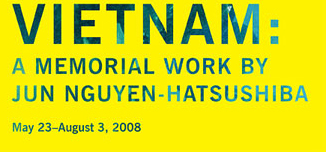 |
 |
|
Curator's Interview with Jun Nguyen-Hatsushiba |
Interview with Jun Nguyen-Hatsushiba Miwako Tezuka: You were first trained as a painter. What inspired you to begin working in video? Jun Nguyen-Hatsushiba: Honestly, it happened by chance. I was planning to do a performance in which I was going to pull a cyclo suspended in a large water tank. To make a long story short, that idea developed into my directing and shooting this video [Memorial Project Nha Trang, Vietnam: Towards the Complex—For the Courageous, the Curious, and the Cowards] under the sea. It was the right medium to turn my idea into a reality. MT: How long have you been interested in cyclos and cyclo drivers? JNH: I have been looking at cyclos and their drivers since I arrived in Vietnam back in 1994. MT: Are all or most cyclo drivers in Vietnam elderly people? Do they still have jobs? JNH: As the cities expand and develop, fewer streets will allow cyclos. As modern means of transportation, such as taxis, become more popular with modern business, cyclos become less and less in demand. In the near future, we may see them only as tourist attractions. MT: How did the cyclo drivers initially react to the proposal of your video project? JNH: They didn't understand it as art, but they thought of it as an interesting project and a challenge. MT: Are the drivers going anywhere specific, and for any purpose? JNH: In a simple narrative sense, they are moving toward the "complex," the place where we had stretched some thirty mosquito nets under the sea. It is a pilgrimage, an offering. MT: What do mosquito nets symbolize? Do they represent rest, repose, security, comfort, or do they mark social and historical boundaries? JNH: They can be all of above and surely more. I use them when I go to sleep every night. MT:You mentioned to me that you recruited local fishermen to perform as the cyclo drivers in your video. Were any of their actions improvisational? Did you write a script to instruct them? JNH: How do you create a script when you want to capture the very nature of human struggle? The drivers are not performing like actors in a film. They were simply asked to move from one area to another in pairs. They found their own way and used their own techniques. One guideline that I gave was just to move forward and not to look at the camera. MT:You have also used the motif of cyclos in sculptural works. You have created remodeled "cyclos of the future." What about these cyclos sets them apart from traditional models? JNH: My models function the same way as traditional cyclos. But I wanted to revitalize the design by accenting some areas like the front section. I used more curves to make the cyclos sportier. Also, with one of the new cyclos, I used stainless steel bars for the frame. MT: Are cyclos still made in Vietnam? Are they only used by tourists or are they objects only preserved in museums? Have they already become a thing of the past? JNH: At one time, I wanted to create a cyclo museum. That idea actually led me to this video. Not many people value the old. Colonial houses are destroyed for new multi-story apartment buildings. Even old trees are cut to broaden streets. Cyclos are still refurbished if anyone needs them fixed; however, this happens less and less. I once owned one to study it but eventually gave it to someone who was looking for a job. I wonder where he is now. MT: What equipment did you use to film Memorial Project Nha Trang, Vietnam—a waterproof digital camera? JNH: I used a Sony single CCD miniDV video camera with an underwater camera housing. I guess this would be considered a toy by today's filmmaking standards. But that was what I had purchased a year ago and it was waiting to be put into action. The quality of equipment that I use has improved since the first video. The second and third videos were shot with similar cameras to the first. For the fourth video, I upgraded to a 3CCD camera. The recent video in Laos was shot with a Sony HD (but not yet full HD). Technology keeps moving forward and sometimes it can get in the way. MT: How long did it take to prepare, shoot, and edit Memorial Project Nha Trang, Vietnam? JNH: It took several months to figure out what I was really going to do. Remember that I was planning to do this in a large water tank in the beginning. It took one week of diving lessons to get a basic and then an advanced certificate. Two weeks later, I began the shoot. The video was shot in nine or ten days I believe. The editing process lasted less than two months. MT: How did you come up with the music? Does it have any specific meaning or source of inspiration? JNH: I used to want to be a musician. I used my 4-track from graduate school to record most of the music for the video. I also worked with pop composer Quoc Bao, who is a friend of mine, to develop some parts. MT: Do you feel any spiritual connection to the works that you create? Your newest video work has a Buddhist motif, while some have found Taoist themes in your minimalist approach to the Nha Trang video. JNH: I think I feel a spiritual connection to many things beyond my work. During the filming of Memorial Project Nha Trang, Vietnam, I remember getting goose bumps looking down at the bottom of the ocean where we had placed the mosquito nets. I interpret goose bumps as an interaction with the supernatural. MT: If I may ask this, have you always hyphenated your last name or was there a defining moment when you decided to do this? You have mentioned before that to have both last names is very important for you and I truly respect that. Would you describe why? JNH: I had two complete names: one in Japanese and another in Vietnamese. I decided to combine them to make things simple. Thus, two last names come from my two names. I decided to hyphenate to show who I am and to respect both of my backgrounds. Above left image courtesy of the artist and Lehmann Maupin Gallery, New York and Mizuma Art Gallery, Tokyo. |